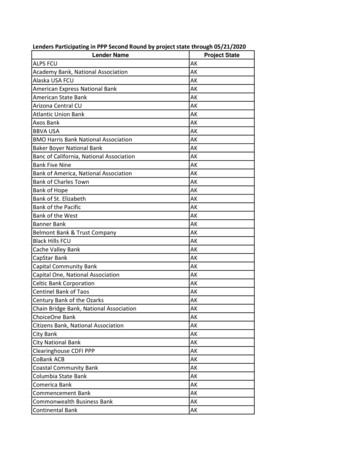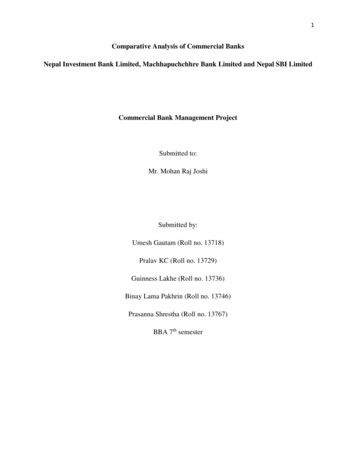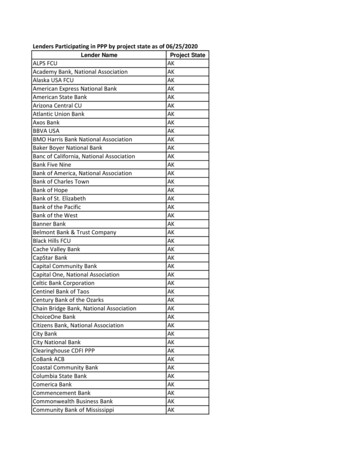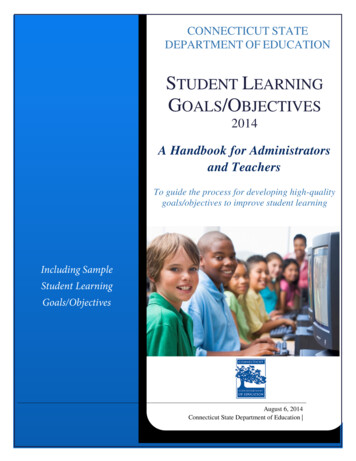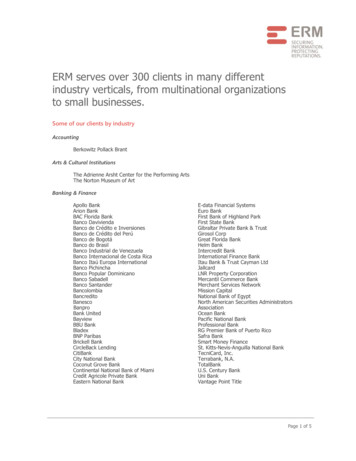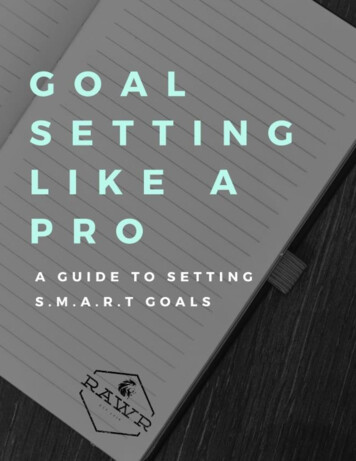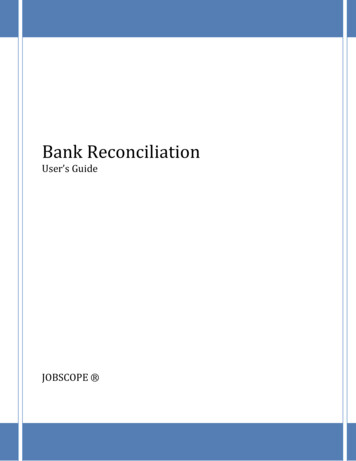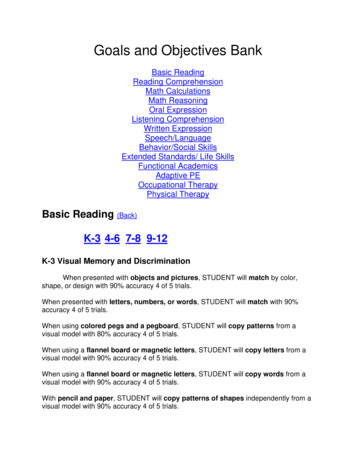
Transcription
Goals and Objectives BankBasic ReadingReading ComprehensionMath CalculationsMath ReasoningOral ExpressionListening ComprehensionWritten ExpressionSpeech/LanguageBehavior/Social SkillsExtended Standards/ Life SkillsFunctional AcademicsAdaptive PEOccupational TherapyPhysical TherapyBasic Reading (Back)K-3 4-6 7-8 9-12K-3 Visual Memory and DiscriminationWhen presented with objects and pictures, STUDENT will match by color,shape, or design with 90% accuracy 4 of 5 trials.When presented with letters, numbers, or words, STUDENT will match with 90%accuracy 4 of 5 trials.When using colored pegs and a pegboard, STUDENT will copy patterns from avisual model with 80% accuracy 4 of 5 trials.When using a flannel board or magnetic letters, STUDENT will copy letters from avisual model with 90% accuracy 4 of 5 trials.When using a flannel board or magnetic letters, STUDENT will copy words from avisual model with 90% accuracy 4 of 5 trials.With pencil and paper, STUDENT will copy patterns of shapes independently from avisual model with 90% accuracy 4 of 5 trials.
With pencil and paper, STUDENT will copy letters independently from a visual modelwith 90% accuracy 4 of 5 trials.With pencil and paper, STUDENT will copy words independently from a visual modelwith 90% accuracy 4 of 5 trials.When presented with hidden picture puzzles and Find Waldo activities, STUDENT willsearch and point out certain objects within the design with 100% accuracy 4 of 5trials.After looking at a picture or photo for one minute, STUDENT will be able to recalldetails with 80% accuracy 4 of 5 trials.When presented with upper and lower case letters, STUDENT will be able todistinguish the difference between the letters with 90% accuracy 4 of 5 trials.When presented with short sentences with familiar words, STUDENT will match theoutlined configurations of individual words with words in a sentence with 80%accuracy 4 of 5 trials.When presented with word cards, STUDENT will alphabetize the words by the firstletter with 80% accuracy 4 of 5 trials.When presented with word cards, STUDENT will alphabetize the words using thesecond letter with 80% accuracy 4 of 5 trials.When given word cards, STUDENT will recognize word endings that show: morethan one (s, es); past tense (ed); ownership (‘s, s’); and contractions with 80%accuracy 4 of 5 trials.While using word cards, STUDENT will combine words to form compound wordswith 80% accuracy 4 of 5 trials.While reading sentences, STUDENT will use context clues to analyze new words andthen read the sentence using the correct pronunciation of the new words with 80%accuracy 4 of 5 trials.When given a series of words, STUDENT will correctly identify the root word with 80%accuracy 4 of 5 trials.When given commonly used sight words, STUDENT will accurately read with 98%accuracy 3 of 4 trials.While using word cards, STUDENT will describe the difference between homophonepairs (ex. new/knew, hear/hear, and their/there/they’re) with 80% accuracy 4 of 5 trials.
While reading a passage orally, STUDENT will demonstrate self-correcting of errorsby pausing in the text, using context clues and phonetic skills, and then rereading thephrase for meaning 90% accuracy 4 of 5 trials.While reading orally, STUDENT will demonstrate reading fluency by making no morethan 2 errors in a one hundred word passage at instructional level 4 of 5 trials.While reading a short play, STUDENT will read aloud using tone/inflectionappropriate to the reading material with 90% accuracy 4 of 5 trials.K-3 Phonics and Word Recognition Skills (Back)When asked, STUDENT will name all upper and lower case letters and identifiesthe representative sounds with 80% accuracy four of five trials.When presented with a, e, i, o, u, and y, STUDENT will distinguish long and shortvowel sounds with 80% accuracy in four of five trials.When presented with single syllable words, STUDENT will distinguish the initial andfinal sounds with 80% accuracy in four of five trials.When reading a story or poem, STUDENT will identify rhyming words when asked with80% accuracy in two of three trials.While reading at instructional level, STUDENT will blend beginning, middle, andending sounds to form words with 80% accuracy in five consecutive sessions.While reading a passage, STUDENT will use knowledge of consonants, consonantblends, and common vowel patterns to decode unfamiliar words with 90% accuracy inthree trials.When presented with printed text, STUDENT will identify common contractions,compound words, and abbreviations with 80 % accuracy four of five trials.While reading a passage, STUDENT will use decoding and word recognition skillswith 80% accuracy four of five trials.When asked, STUDENT will read a 100 word story at instructional level making no morethan 8 oral reading errors and will answer 3 of 5 comprehension questions correctly3 consecutive days.When shown a list of 30 blend-vowel and digraph-vowel combinations, STUDENTwill give the correct sound of the initial blend or digraph at 100% accuracy 5 consecutivedays.
Given a passage at instructional level, STUDENT will read a 100 word passage in lessthan 2 minutes making no more than 12 oral reading errors for 5 consecutivesessions.Given the basic sight words, STUDENT will read 100 sight words with 100% accuracyon 5 consecutive trials.Given a list of vocabulary words, STUDENT will read the words correctly with 90%accuracy in 3/4 trials.K-3 Auditory Discrimination (Back)When presented with a tape of sounds (music sounds, animals sounds, andenvironmental sounds), STUDENT will identify the common sounds with 80%accuracy 4 of 5 trials.With HIS back to the teacher and after listening to a pattern of sounds made by theteacher with sound-producing instruments, STUDENT will turn to face the teacher andduplicate the pattern heard with 80% accuracy 8 of 10 trials.After listening to the teacher read a series of words beginning with the same consonant,STUDENT wills either supply the name of the letter heard or choose the correct letterfrom two letter cards with 90% accuracy 8 of 10 trials.When presented with word and picture cards, STUDENT recognize and discriminate thefinal sounds of n, d, k, m, t, and p with 90% accuracy 4 of 5 trials.After being presented with a very short story or sets of sentences that include wordswith one or two target ending sounds, STUDENT will circle words ending with thesame sound with 80% accuracy 4 of 5 trials.When presented with words with double consonant patterns, like rolling and stopping,STUDENT will correctly read the words with 80% accuracy 4 of 5 trials.When given words with silent consonants (l, t, k, h, b, gh, w, and ph), STUDENT willcorrectly read the words with 80% accuracy 4 of 5 trials.When given a list of words with initial sound blends (st, pl, bl, br, tr, dr, gr, fr, cr, sn, sl,pr, cl, thr, gl, squ, spr, and str), STUDENT will recognize the blend and read the wordcorrectly with 80% accuracy 4 of 5 trials.As STUDENT listens to the teacher read a list of words, HE will identify the words withthe hard and soft sounds produced by c with 80% accuracy 4 of 5 trials.
When presented with words with y, STUDENT will correctly identify and read wordsusing the long and short sounds of y with 80% accuracy 4 of 5 trials.When presented with words with short vowel sounds, STUDENT will correctly readthe words with 80% accuracy 4 of 5 trials.When presented with a list of CVC words, STUDENT will correctly read the words with80% accuracy 4 of 5 trials.When presented with a list of words with long and short vowel sounds, STUDENT willcorrectly read the words with 80% accuracy 4 of 5 trials.When presented with lists of words with vowel digraphs (ee, ea, ai, and oa),STUDENT will correctly read the words with 80% accuracy 4 of 5 trials.When presented with lists of words, STUDENT will recognize and correctly read wordswith “ r “ controlled vowels such as er, ir, and ar sounds with 80% accuracy 4 of 5trials.When presented with lists of words with vowel diphthongs (ou, ow, oi, oy, aw, and au),STUDENT will correctly read the words with 80% accuracy 4 of 5 trials.When presented with lists of words with consonant diphthongs (th, ch, sh, and tch),STUDENT will correctly read the words with 80% accuracy 4 of 5 trials.When presented with verbs with verb tenses, STUDENT will recognize the word andread correctly with 80% accuracy 4 of 5 trials.When presented with highly predictable rhyming books/poems, STUDENT will read theprint aloud and supply missing rhymes with 80% accuracy 4 of 5 trials.When presented with multi-syllabic words, STUDENT will correctly identify thenumber of syllables in each word with 80% accuracy 4 of 5 trials.When presented with lists of words, STUDENT will correctly read the word and identifythe prefix and/or suffix in each word with 80% accuracy 4 of 5 trials.K-3 Auditory Memory (Back)After listening to the teacher read a series of words, STUDENT will correctly repeat aseries of 4 words with 80% accuracy 4 of 5 trials.When presented with a set of 4 oral directions, STUDENT will accurately complete thetasks assigned in the correct order with 80% accuracy 4 of 5 trials.
When asked, STUDENT will demonstrate recall of details from a past classexperience or discussion by accurately summarizing 5 events from the previous day on5 consecutive days.When asked to deliver a message, STUDENT will remember and relay an oralmessage accurately with 100% accuracy on three consecutive days.K-3 Reading for Pleasure (Back)During an established free reading time of 10 to 15 minutes, STUDENT will selectappropriate reading material, read independently, and then share what interestedthem in their reading when asked 3 of 4 times.After reading outside of class, STUDENT will write a one sentence reaction to theirreading 3/5 days for three consecutive weeks at 100% accuracy.4-6 Basic Reading (Back)Given a list of 20 words with prefixes and suffixes, STUDENT will identify the rootword, prefix and suffix with 90% accuracy 5 consecutive trials.Given a passage to orally read, STUDENT will use context clues to determine unknownwords, reading with an 90% accuracy 4/5 times.While reading a passage, STUDENT will use knowledge of consonants, consonantblends, and common vowel patterns to decode unfamiliar words with 90% accuracy inthree trials.When presented with printed text, STUDENT will identify common contractions,compound words, and abbreviations with 80 % accuracy four of five trials.While reading a passage, STUDENT will use decoding and word recognition skillswith 80% accuracy four of five trials.Given a list of 10 vocabulary words, STUDENT will use words in sentences applyingcorrect meaning to the words 90% accuracy 5 consecutive trials.Given 10 sentences with underlined words, STUDENT will use prior word structureknowledge to determine the meaning of underlined word with 90% accuracy 9/10 trials.7-8 Basic Reading (Back)
When given a list of 10 vocabulary words, STUDENT will correctly divide them intosyllables with 80% accuracy in 4 of 5 trials.7-8 Content Area Reading (Back)When using a content area textbook, STUDENT will demonstrate an understanding ofthe table of contents, an index, and a glossary by responding to teacher directedquestions with 80% accuracy 4 of 5 trials.When completing an assignment, STUDENT will skim a content area readingassignment to respond to questions with 80% accuracy 4 of 5 trials.After reading and familiarizing self with a variety assignments, STUDENT will identifyimportant information in individual content areas and their textbooks and completeassignments with a 75% average over a period of 20 school days.While reading, STUDENT will take notes using bold titles and subtitles to develop anoutline of main ideas and details upon the teacher’s request with 80% accuracy 5 of 5trials.When using a listening guide developed by the teacher, STUDENT will listen to acontent area lecture and fill in the details on the listening guide with 80% accuracy 5 of5 trials.When presented with questions, STUDENT will interpret charts, maps, and/ordiagrams to find answers with 80% accuracy 4 of 5 trials.When reading a chapter, STUDENT will identify new vocabulary or concepts withintext and after reading the pertinent text will accurately describe new words andconcepts to obtain 80% accuracy on related content area assignments over a period of20 days.After reading a content area reading assignment, STUDENT will correctly identify themain idea of the paragraph or passage with 90% accuracy 4 of 5 trials.After reading an assigned content area reading passage, STUDENT will accuratelypredict information to be covered in the next reading section or chapter with 80%accuracy 4 of 5 trials.After reading an assigned content area reading passage, STUDENT will arrangeevents in sequential order, such as according to time, level of importance, or causeand effect with 80% accuracy 4 of 5 trials.
While memorizing content area concepts, STUDENTS will use mnemonics to helprecall information resulting in an average of 80% accuracy on tests and quizzes incontent area classes 4/5 trials.To complete assignments, STUDENT will read and use information from two othersources, such as the internet, encyclopedias, and almanacs, on 2 of 3 trials.When reading an assigned content area reading passage, STUDENT will apply wordattack skills to content area words allowing STUDENT to pronounce words correctlyin a 100 word passage with 90% accuracy 2 of 3 trials.When STUDENT finishes reading a nonfiction selection, HE will summarize theinformation by writing a paragraph with a topic sentence, three supportive sentencesand a conclusion with 80% accuracy 2 of 3 trials.7-8 Vocabulary (Back)When listening to a story, STUDENT will provide words that make sense within thecontext when asked by the teacher with 80 accuracy in 4 of 5 trials.After being introduced to the subject of a story, STUDENT will predict the vocabularyto be used in the story and will use four of five of these words in sentences 3 of 4 trials.While completing a cloze activity, STUDENT will provide words demonstrating anunderstanding of syntax and vocabulary with 80% accuracy 3 of 4 trials.When completing an assignment, STUDENT will demonstrate an understanding ofsynonyms and antonyms with accuracy of 80% 4 of 5 trials.When presented with common homonyms like sea/see, blew/blue, and whole/hole,STUDENT will provide correct word to complete sentences with 80% accuracy 4 of 5trials.Upon request, STUDENT will provide prefixes and suffixes to words in a sentencewith 80% accuracy 4 of 5 trials.When given a list of words, STUDENT will categorize words with 80% accuracy 4 of 5trials.Given within the context of reading material, STUDENT will provide definitions of newwords with 80% accuracy 4 of 5 trials.Given within the context of reading material, STUDENT will choose the correctdictionary meaning to fit a word with 80% accuracy 4 of 5 trials.
Given a list of new words with familiar root words, STUDENT will recognize and identifyroot words with 80% accuracy 4 of 5 trials.Upon request, STUDENT will develop a study guide of frequently read and usedmultiple meaning words (ex. tie, plain, scale, draft, and sentence) and their meaningswith 80% accuracy and 4 of 5 trials.While reading newspapers and magazines, STUDENT will identify common acronymsand provide their meaning with 100% accuracy 4 of 5 trials.9-12 Vocabulary (Back)When given a list of 10 vocabulary words, STUDENT will correctly define and writethem in a sentence 4/5 times with 90% accuracy.When given a list of 10 vocabulary words, STUDENT will correctly spell them 4/5times with 90% accuracy.Reading Comprehension (Back)K-3 4-6 7-8 9-12K-3After reading or looking at a simple storybook, STUDENT will identify the main idea80% of the time 4 of 5 trials.When presented with a passage at instructional level, STUDENT will read to confirminitial predictions with 80% accuracy 4 of 5 trials.After reading a story, STUDENT will explain the sequence of events with 80% accuracyfour of five trials.After reading a story at instructional level, STUDENT will identify the main idea and twosupporting details with 80% accuracy four of five trials.When presented with how, why, and what-if questions after reading a story silently,STUDENT will answer comprehension questions with 80% accuracy four of five trials.When asked, STUDENT will identify homonyms, synonyms, and antonyms and useappropriately in sentences with 80% accuracy four of five trials.After reading a story, STUDENT will identify the effect of a certain action with 80%accuracy 4 of 5 trials.
After reading a story, STUDENT will identify the cause of a situation with 80% accuracy4 of 5 trials.After reading a story at instructional level, STUDENT will distinguish between causeand effect with 80% accuracy four of five times.After reading a story at instructional level, STUDENT will distinguish between fact andopinion with 80% accuracy four of five trials.While listening to a story, STUDENT will recognize the difference between fantasy andreality with 80% accuracy 4 of 5 trials.After reading a short story, STUDENT will answer oral comprehension questions with80% accuracy in 4/5 trials.After reading a short story, STUDENT will answer written comprehension questionswith 80% accuracy in 4/5 trials.When reading a story, STUDENT will demonstrate an understanding of the use ofquotation marks with 80% accuracy 4 of 5 trials.4-6 (Back)After reading a short passage, STUDENT will use text information and priorknowledge to make predictions, 4/5 times with 80% accuracy.After reading a short passage, STUDENT will predict outcomes, 4/5 times with 90%accuracy.After silently reading a passage, STUDENT will determine cause and effect using theinformation derived from the test, 4/5 times with 80% accuracy.After silently reading a passage, STUDENT will use context and semantic clues toanswer comprehension questions, 4/5 times with 80% accuracy.After reading various imaginative forms of literature, STUDENT will be able to identifyand describe the structural differences of written forms, 4/5 times with 80% accuracy.During library time, STUDENT will independently select a library book appropriate forHIS purpose and instructional level in 2 of 2 trials.After silently reading a short story, STUDENT will identify the author’s purpose, 4/5times 90% accuracy.After given a reading assignment, STUDENT will demonstrate use ofreading strategies to comprehend text, 4/5 times with 80% accuracy.skimming
After reading a short passage and answering comprehension questions, STUDENTwill locate, in text, information to support answers, 4/5 times with 90% accuracy.After reading a short passage, STUDENT will use implied meaning tocomprehension questions, 4/5 times with 80% accuracy.answerAfter reading various statements, STUDENT will identify fiction andnonfiction statements, 4/5 times with 90% accuracy.After reading various statements, STUDENT will distinguish fact fromtimes with 90% accuracy.opinion, 4/5After given various information, STUDENT will use text organizers to locatecategorize information in printed material, 4/5 times with 90% accuracy.After reading a passage, STUDENT will recognize figurative use of4/5 times with 80% accuracy.andlanguage,After reading a passage, STUDENT will identify the mood of the reading selection with80% accuracy 4 of 5 trials.After reading a story, STUDENT will identify details most important to the plot with 80%accuracy 4 of 5 trials.7- 8 (Back)After reading a book at instructional level, STUDENT will answer literal comprehensionquestions at 80% accuracy in 2 of 3 trials.After reading a book at instructional level, STUDENT will answer inferentialcomprehension questions at 70% accuracy in 2 of 3 trials.Given a worksheet or review sheet from a content area, STUDENT will read nonfictionmaterial and write the answers at 70% accuracy in 4 of 5 trials.Given access to a variety of poetry, STUDENT will correctly identify one example ofeach of the following types of figurative language: simile, metaphor, personification,alliteration and hyperbole at 100% accuracy in 2 of 3 trials.After reading a story, STUDENT will identify the characters, setting, rising action, climaxand resolution on a plot line chart with 80% accuracy in 2 of 3 trials.After reading a selection, STUDENT will describe the character’s physical appearanceand personality as well as if they changed (dynamic) or did not change (static) duringthe story with 80% accuracy in 2 of 3 trials.
After reading a selection, STUDENT will identify the main idea of the passage with 80%accuracy in 4 of 5 trials.While reading, STUDENT will vary reading rate according to the purpose of reading asobserved by the teacher 8 of 10 trials.9-12 (Back)When given a reading passage, STUDENT will use questioning strategies to increasecomprehension of what was read 4/5 times with 90% accuracy.After reading a passage, STUDENT will understand the passage’s tone, character,point-of-view, and theme 4/5 times with 90% accuracy.After reading a passage, STUDENT will identify the author’s purpose 4/5 times with90% accuracy.After reading a passage, STUDENT will recognize the difference between fact andopinion 4/5 times with 90% accuracy.When given a passage, STUDENT will read and predict the outcome 4/5 times with90% accuracy.After reading a passage, STUDENT will recognize figurative use of language 4/5times with 90% accuracy.After reading a passage, STUDENT will identify the cause of the situation 4/5 times with90% accuracy.After reading a passage, STUDENT will predict the main problem 4/5 times with 90%accuracy.After reading a passage, STUDENT will predict the ending of the story 4/5 times with90% accuracy.After reading a passage, STUDENT will identify the details most important to the plot4/5 times with 90% accuracy.After reading a passage, STUDENT will compare and contrast people, things andideas 4/5 times with 90% accuracy.When given a passage of various levels of sentence structure, STUDENT will read thematerial with 90% accuracy in 4/5 trials.
When given an assignment, STUDENT will read and follow instructions to usecomputer software, assemble or construct models or equipment, or complete a project4/5 times with 90% accuracy.When given an assignment, STUDENT will use the reading process to understanddirections and procedures (example: directions for home and school, schedules,maps) 4/5 times with 90% accuracy.When questioned by the teacher, STUDENT will demonstrate an understanding of thepurpose of variations in print (words in all capitals or boldface) by correctly responding80% of the time 4 of 5 trials.While reading a passage, STUDENT will use rereading to make sense of the passageand confirm their predictions resulting in correct responses to questions with 80%accuracy 4 of 5 trials.While reading a passage, STUDENT will use context clues to understand new wordsor phrases resulting in correct responses to questions with 80% accuracy 4 of 5 trials.When completing theme units, STUDENT will use survival words correctly in areas, likesigns, cooking, restaurants, medicine, jobs, and driving with 80% accuracy 4 of 5 trials.Math Calculations (Back)K-3 4-6 7-8 9-12K-3 Addition and SubtractionGiven two or more sets of manipulatives, STUDENT will apply the concept of additionto combine the sets and find the total amount with 80% accuracy in 4/5 trials.Given two or more sets of manipulatives, STUDENT will apply the concept ofsubtraction to find the difference in numeric value between the two sets with 80%accuracy in 4/5 trials.Given number sentences without an , - or sign, STUDENT will use the rightsymbol to complete the number sentence with 80% accuracy in 4/5 trials.Given basic flash cards, STUDENT will recall basic addition and subtraction factsthrough the nines with 80% accuracy in 4/5 trials.
Given problems orally or on paper, STUDENT will add numbers to 20 with 80%accuracy in 4/5 trials.Given a set of numbers 0-20, STUDENT will subtract the smaller from the largernumber and find the correct answer with 80% accuracy in 4/5 trials.Given a set of addition and subtraction equations, STUDENT will write the inverserelationship between subtraction and addition problems with 80% accuracy in 4/5trials.Given a set of numbers, STUDENT will solve two digit addition problems withoutregrouping with 80% accuracy in 4/5 trials.Given a set of numbers, STUDENT will solve two digit addition and subtractionproblems with regrouping with 80% accuracy in 4/5 trials.Given a set of numbers, STUDENT will add and subtract multi-digit whole numbersusing various computational methods with 80% accuracy in 4/5 trials.Given a set of fractions with like denominators, STUDENT will add and subtractwith 80% accuracy in 4/5 trials.K-3 Multiplication and Division (Back)Given basic multiplication flash cards, STUDENT will recall multiplication factsthrough the nines with 80% accuracy in 4/5 trials.Given basic division flash cards, STUDENT will recall division facts through the nineswith 80% accuracy in 4/5 trials.Given a set of numbers, STUDENT will multiply a 2-3 digit number by a one digitnumber with 80% accuracy in 4/5 trials.Given a set of numbers, STUDENT will divide a 2-3 digit number by a one digitnumber with 80% accuracy in 4/5 trials.4-6 Algebra Standards (Back)Given one-step equations, STUDENT will solve them at 80% accuracy in 4 of 5 trials.Given a multi-step problem, STUDENT will use order of operations to solve at 80%accuracy in 4 of 5 trials.
Given a one-step equation with fractions and decimals, STUDENT will solve usinginverse operations at 80% accuracy in 4 of 5 trials.Given ordered pairs, STUDENT will graph them on a coordinate plane with 90%accuracy in 4 of 5 trials.4-6 Geometry Standards (Back)Given a coordinate grid, STUDENT will find locations to represent points and simplefigures at 80% accuracy in 4 of 5 trials.4-6 Measurement Standards (Back)Given a variety of measurement problems, STUDENT will convert to another unit ofmeasure at 80% accuracy in 4 of 5 trials.Given a set of coins, STUDENT will state the value of the coins at 80% accuracy in 4of 5 trials.Given a set of coins and bills, STUDENT will state the value at 80% accuracy in 4 of5 trials.Using a formula, STUDENT will solve area and volume problems at 80% accuracy in 4of 5 trials.Given an object, STUDENT will measure to the nearest eighth inch at 80% accuracyin 4 of 5 trials.Given an object, STUDENT will measure to the nearest millimeter at 80% accuracy in4 of 5 trials.Given an angle, STUDENT will measure the degrees in the angle at 80% accuracy in4 of 5 trials.4-6 Number Sense Standards (Back)Given a set of numbers, STUDENT will add and subtract large numbers withregrouping with 80% accuracy in 4/5 trials.Given a set of mixed numbers, STUDENT will add and subtract with 80% accuracy in4/5 trials.Given a set of mixed numbers, STUDENT will multiply and divide with 80% accuracyin 4/5 trials.
Given a set of numbers, STUDENT will list five multiples of numbers less than 400 at80% accuracy in 4 of 5 trials.Given a set of numbers, STUDENT will list all the factors of numbers less than 400 at80% accuracy in 4 of 5 trails.Given a set of numbers, STUDENT will give the value of numbers that are squaredand cubed at 80% accuracy in 4 of 5 trials.Given a set of negative numbers, STUDENT will plot them on a number line at 80%accuracy in 4 of 5 trials.Given a set of numbers, STUDENT will multiply and divide any number by a two digitnumber with 80% accuracy in 4/5 trials.Given a set of multiplication problems with multiplicands and multipliers 0-12,STUDENT will solve at 80% accuracy in 4 of 5 trials.Given a set of division problems with divisors and dividends 0-12, STUDENT will findthe quotient at 80% accuracy in 4 of 5 trials.Given a set of multi-digit numbers, STUDENT will find the product at 80% accuracyin 4 of 5 trials.Given a set of division problems with whole numbers, STUDENT will find thequotient at 80% accuracy in 4 of 5 trials.Given two unlike fractions, STUDENT will find the common denominator and makeequivalent fractions at 90% accuracy in 4 of 5 trials.Given ten fractions, STUDENT will reduce them to lowest terms at 90% accuracy in 4of 5 trials.Given unlike fractions, STUDENT will add and subtract with 80% accuracy in 4 of 5trials.Given a set of fraction problems, STUDENT will multiply and divide at 80% accuracyin 4 of 5 trials.Given a set of decimal problems, STUDENT will add and subtract with regrouping at80% accuracy in 4 of 5 trials.Given a set of decimal problems, STUDENT will multiply and divide at 80% accuracyin 4 of 5 trials.
Given a set of numbers, STUDENT will find the least common multiple and greatestcommon factor at 80% accuracy in 4 of 5 trials.Given a multi-step word problem, STUDENT will solve at 80% accuracy in 4 of 5trials.Given a set of integers, STUDENT will add and subtract them with 80% accuracy in 4of 5 trials.4-6 Patterns, Relations, and Functions Standards (Back)Given a number of units and total cost, STUDENT will find the unit cost at 80%accuracy in 4 of 5 trials.4-6 Statistics & Probability Standards (Back)Given a set of numbers, STUDENT will find the mean, median, mode, and range at80% accuracy in 4 of 5 trials.7-8 Algebra Standards (Back)Given algebraic expressions, STUDENT will replace variables and solve with 80%accuracy in 4 of 5 trials.Given one-step equations and inequalities, STUDENT will solve using inverseoperations at 80% accuracy in 4 of 5 trials.Given an equation, STUDENT will solve and graph equations and inequalities at 80%accuracy in 4 of 5 trials.7-8 Geometry Standards (Back)Using the Pythagorean theorem, STUDENT will solve problems at 80% accuracy in 4of 5 trials.Using a formula, STUDENT will solve volume and surface area problems at 80%accuracy in 4 of 5 trials.Given a multiple step formula, STUDENT will substitute values and solve at 80%accuracy in 4 of 5 tria
Given a passage at instructional level, STUDENT will read a 100 word passage in less than 2 minutes making no more than 12 oral reading errors for 5 consecutive sessions. Given the basic sight words, STUDENT will read 100 sight words with 100% accuracy on 5 consecutive trials. Given a list of vocabulary

